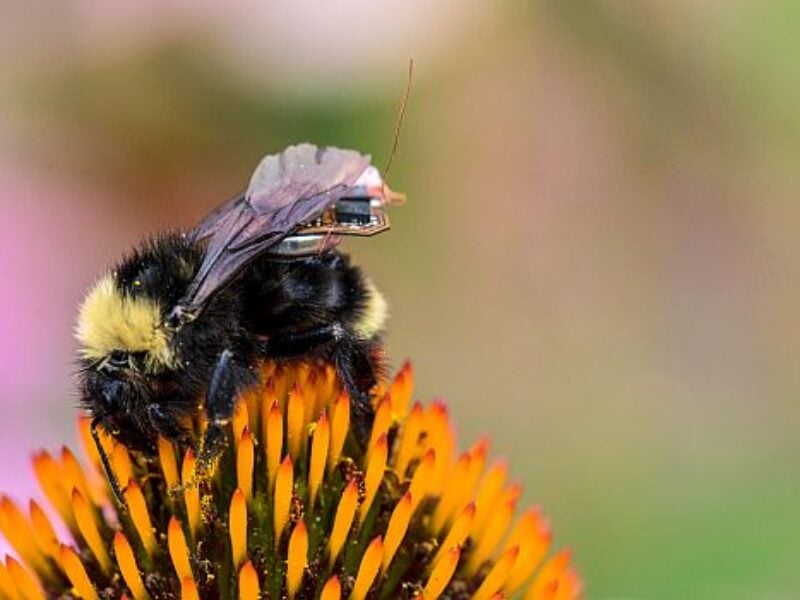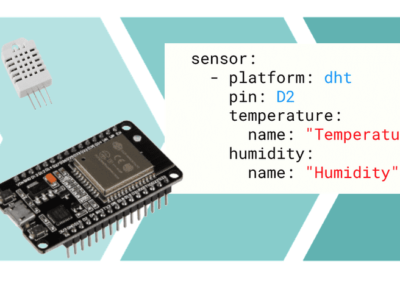
‘Living IoT’ sensor system rides on bees instead of drones
“UAV drones can fly for maybe 10 or 20 minutes before they need to charge again, whereas our bees can collect data for hours,” said Prof Shyam Gollakota form the Paul G. Allen School of Computer Science & Engineering. “We showed for the first time that it’s possible to actually do all this computation and sensing using insects in lieu of drones.”
“We decided to use bumblebees because they’re large enough to carry a tiny battery that can power our system, and they return to a hive every night where we could wirelessly recharge the batteries,” said Vikram Iyer, a doctoral student in the UW Department of Electrical & Computer Engineering. “For this research we followed the best methods for care and handling of these creatures.”
The team designed a sensor backpack that rides on the bees’ backs and weighs 102 milligrams, or about the weight of seven grains of uncooked rice.

“The rechargeable battery powering the backpack weighs about 70 milligrams, so we had a little over 30 milligrams left for everything else, like the sensors and the localization system to track the insect’s position,” said co-author Rajalakshmi Nandakumar, a doctoral student in the Allen School.
GPS receivers are too power-hungry to ride on a tiny insect, so the team came up with a method that uses no power to localize the bees. They used multiple antennas that broadcast a signal from a base station across a specific area. A receiver in a bee’s backpack uses the strength of the signal and the angle difference between the bee and the base station to triangulate the insect’s position.
“To test the localization system, we did an experiment on a soccer field,” said Anran Wang, a doctoral student in the Allen School. “We set up our base station with four antennas on one side of the field, and then we had a bee with a backpack flying around in a jar that we moved away from the antennas. We were able to detect the bee’s position as long as it was within 80 meters, about three-quarters the length of a football field, of the antennas.”
The team then added a series of small sensors for monitoring temperature, humidity and light intensity to the backpack. This allowed the pack to collect data and log that information along with the location, and eventually compile information about a whole farm.
“It would be interesting to see if the bees prefer one region of the farm and visit other areas less often,” said Sawyer Fuller, an assistant professor in the UW Department of Mechanical Engineering. “Alternatively, if you want to know what’s happening in a particular area, you could also program the backpack to say: ‘Hey bees, if you visit this location, take a temperature reading.'”
Then after the bees have finished their day of foraging, they return to their hive where the backpack can upload any data it collected via a method called backscatter, through which a device can share information by reflecting radio waves transmitted from a nearby antenna.
Right now the backpacks can only store about 30 kilobytes of data, so they are limited to carrying sensors that create small amounts of data. Also, the backpacks can upload data only when the bees return to the hive. The team would eventually like to develop backpacks with cameras that can livestream information about plant health back to farmers.
“Having insects carry these sensor systems could be beneficial for farms because bees can sense things that electronic objects, like drones, cannot,” said Gollakota. “With a drone, you’re just flying around randomly, while a bee is going to be drawn to specific things, like the plants it prefers to pollinate. And on top of learning about the environment, you can also learn a lot about how the bees behave.”
Related stories:
POLLEN DERIVED BATTERY ELECTRODES OFFER SUSTAINABLE SOLUTION
ZERO POWER SENSOR TECHNOLOGY SPINS OUT INTO STARTUP
 If you enjoyed this article, you will like the following ones: don't miss them by subscribing to :
eeNews on Google News
If you enjoyed this article, you will like the following ones: don't miss them by subscribing to :
eeNews on Google News



